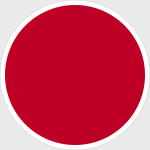Hobby Master HA8803 Imperial Japanese Navy Mitsubishi A6M2 "Zero" Fighter - Tetsuzo Iwamoto, 201st Naval Flying Group, Rabaul, November 1943 (1:48 Scale)
"We have resolved to endure the unendurable and suffer what is insufferable."
- Japanese Emperor Hirohito speaking to the Japanese people after the atomic bombings, August 1945
 The Mitsubishi A6M "Zero" is a long-range carrier-based fighter aircraft formerly manufactured by Mitsubishi Aircraft Company, a part of Mitsubishi Heavy Industries. It was operated by the Imperial Japanese Navy (IJN) from 1940 to 1945. The A6M was designated as the Mitsubishi Navy Type 0 carrier fighter, or the Mitsubishi A6M Rei-sen. The A6M was usually referred to by its pilots as the Reisen (zero fighter), "0" being the last digit of the imperial year 2600 (1940) when it entered service with the Imperial Navy. The official Allied reporting name was "Zeke", although the name "Zero" was used colloquially as well.
The Mitsubishi A6M "Zero" is a long-range carrier-based fighter aircraft formerly manufactured by Mitsubishi Aircraft Company, a part of Mitsubishi Heavy Industries. It was operated by the Imperial Japanese Navy (IJN) from 1940 to 1945. The A6M was designated as the Mitsubishi Navy Type 0 carrier fighter, or the Mitsubishi A6M Rei-sen. The A6M was usually referred to by its pilots as the Reisen (zero fighter), "0" being the last digit of the imperial year 2600 (1940) when it entered service with the Imperial Navy. The official Allied reporting name was "Zeke", although the name "Zero" was used colloquially as well.
The Zero is considered to have been the most capable carrier-based fighter in the world when it was introduced early in World War II, combining excellent maneuverability and very long range. The Imperial Japanese Navy Air Service also frequently used it as a land-based fighter.
In early combat operations, the Zero gained a reputation as a dogfighter, achieving an outstanding kill ratio of 12 to 1, but by mid-1942 a combination of new tactics and the introduction of better equipment enabled Allied pilots to engage the Zero on generally equal terms. By 1943, the Zero was less effective against newer Allied fighters. The Zero lacked hydraulic boosting for its ailerons and rudder, rendering it difficult to maneuver at high speeds. Lack of self-sealing fuel tanks also made it more vulnerable than its contemporaries. By 1944, with Allied fighters approaching the A6M's levels of maneuverability and consistently exceeding its firepower, armor, and speed, the A6M had largely become outdated as a fighter aircraft. However, as design delays and production difficulties hampered the introduction of newer Japanese aircraft models, the Zero continued to serve in a front-line role until the end of the war in the Pacific. During the final phases, it was also adapted for use in kamikaze operations. Japan produced more Zeros than any other model of combat aircraft during the war.
Pictured here is a 1:48 scale replica of an Imperial Japanese Navy Mitsubishi A6M2 "Zero" fighter that was piloted by Tetsuzo Iwamoto, who was attached to the 201st Naval Flying Group, then deployed to Rabaul during November 1943.
Sold Out!
Dimensions:
Wingspan: 9-inches
Length: 7-1/4-inches
Release Date: June 2018
Historical Account: "Pacific Ace" - Lieutenant Junior Grade Tetsuzō Iwamoto was one of the top scoring aces among Imperial Japanese Navy Air Service (IJNAS) fighter pilots. He entered the Imperial Navy in 1934 and completed pilot training in December 1936. His first combat occurred over China in early 1938. He emerged as the top ace of the Imperial Japan during WWII, credited with at least 87 aerial victories including 14 victories in China. Subsequently, he flew Zeros from the aircraft carrier Zuikaku from December 1941 to May 1942, including at the Battle of the Coral Sea.
In late 1943, Iwamoto's air group was sent to Rabaul, New Britain, resulting in three months of air combat against Allied air raids.
Subsequent assignments were Truk Atoll in the Carolines and the Philippines, being commissioned an ensign in October 1944. Following the evacuation of the Philippines, Iwamoto served in home defense and trained kamikaze pilots.
As a result of the Japanese use of the British naval practices, the IJNAS scoring system was based on the system the Royal Navy and the Royal Air Force (RAF) adopted from World War I until World War II. This system differed from the scoring system used by some other nations during World War II. Research by academics surnamed Izawa and Hata in 1971 estimated his score at about 80 or more than 87. In December 1993, Izawa wrote that Iwamoto was virtually the top ace of the IJNAS.
As of mid-1944, there remained only two IJNAS fighter pilots who were credited with over 100 victories. Depending on various totals cited, Tetsuzō Iwamoto or Hiroyoshi Nishizawa was Japan's top ace. Iwamoto was known as the Chūtai leader (Flying Company, squadron of 8 to 16 fighters). Iwamoto was one of few survivors of the IJNAS from the early part of the Second World War. He fought over the Indian and the Pacific Ocean from north to south, and trained young pilots even in the last months of the war. Like many Japanese veterans, Iwamoto was reported to have fallen into depression after the war. His diary was found after his death, with claims of 202 Allied aircraft destroyed.


